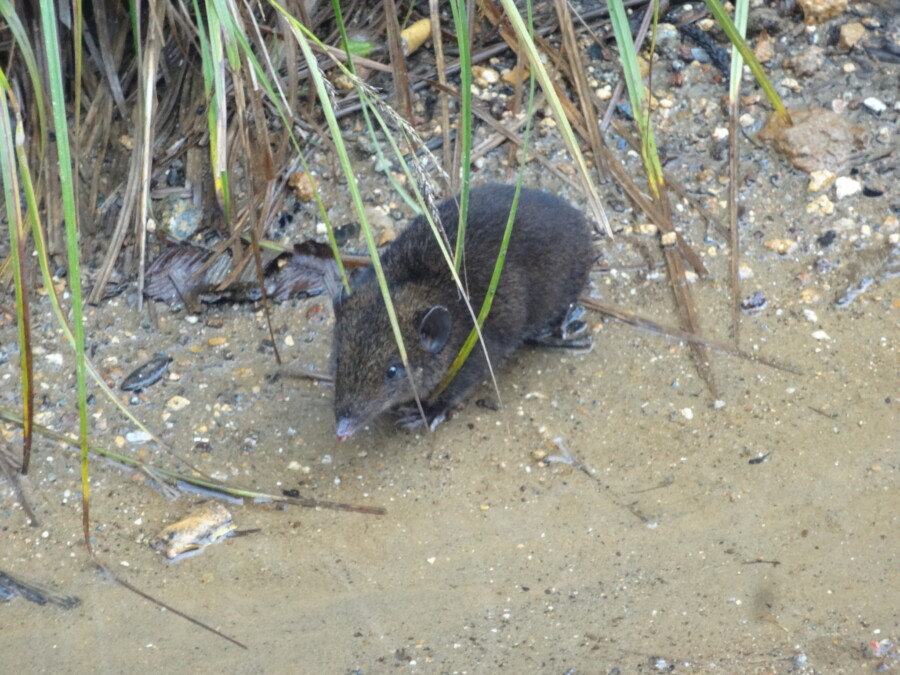Scientists found five new kinds of small, furry hedgehogs in the forests of South East Asia. They went on trips to the forest and also looked at old hedgehog samples in museums. They found two new kinds in the museums and three more in the forest. Dr. Melissa Hawkins, who led the team, said this shows us how many different living things there are on Earth and reminds us to take care of the forests.
These new hedgehogs are part of a group called Hylomys and they live in South East Asia. Before, people only knew about two kinds, but now there are seven. These hedgehogs have fur, not spiky backs, and they have long noses. Dr. Arlo Hinckley, who helped with the study, said finding these animals is important because the forests where they live are being cut down a lot.
Finding new animals is hard, especially when they are small and look alike, and live in thick forests. But the scientists could tell the hedgehogs apart by looking closely at their genes and at their skulls and teeth. They also found two kinds of hedgehogs in museums that no one knew were different. Their research, which they wrote about in a science journal, helps us learn more about these special hedgehogs and why we should protect the places they live.
Original news source: Five new soft-furred hedgehog species discovered (BBC)
🎧 Listen:
Slow
Normal
Fast
📖 Vocabulary:
| 1 | scientists | People who study things to learn and find new information |
| 2 | species | Different kinds or groups of animals or plants |
| 3 | samples | Small parts taken from something to study or look at later |
| 4 | museums | Places where you can see old things, like bones or art |
| 5 | forests | Big areas with lots of trees and plants |
| 6 | genes | Tiny parts inside your body that decide how you look and grow |
| 7 | skulls | The bones that make up the head |
| 8 | teeth | The hard, white things in your mouth that you use to chew food |
| 9 | research | Careful study to learn more about something |
| 10 | journal | A book where people write about new things they have learned |
| 11 | protect | To keep someone or something safe from harm or danger |
| 12 | furry | Covered with a soft, thick hair |
Group or Classroom Activities
Warm-up Activities:
– Charades
Instructions: Divide the class into small groups. Each group will take turns choosing a word or phrase related to the article and acting it out without speaking. The other groups will try to guess what they are acting out. Encourage the use of gestures and body language to convey the meaning.
– News Summary
Instructions: Have the students work individually or in pairs to write a summary of the article using their own words. Encourage them to include the main points and key details. Afterward, have a class discussion and compare the different summaries.
– Opinion Poll
Instructions: Ask the students to think about their own opinion on the importance of protecting the forests and the animals that live in them. Have them write down their opinion and then pair up with a classmate to discuss their reasons. Afterward, conduct a class poll to see the different opinions and have a class discussion.
– Vocabulary Pictionary
Instructions: Create a list of vocabulary words from the article (e.g. hedgehog, forests, genes) and write them on separate pieces of paper. Divide the class into small groups. One student from each group will pick a word and draw a picture on the board without speaking. The other group members will try to guess the word based on the drawing.
– Think-Pair-Share
Instructions: Ask the students to think about one thing they learned from the article that they found interesting or surprising. Have them pair up with a classmate and take turns sharing their thoughts. Then, have a class discussion and ask a few students to share their thoughts with the whole class.
🤔 Comprehension Questions:
1. What did scientists find in the forests of South East Asia?
2. Where else did the scientists find new kinds of hedgehogs?
3. How many new kinds of hedgehogs did the scientists find in total?
4. What is special about these hedgehogs’ fur?
5. Why is it important to find these animals?
6. How did the scientists tell the hedgehogs apart?
7. What did the scientists write about in a science journal?
Go to answers ⇩
🎧✍️ Listen and Fill in the Gaps:
Scientists found five new (1)______ of small, (2)______ hedgehogs in the forests of South East Asia. They went on trips to the forest and also looked at old hedgehog samples in museums. They found two new kinds in the museums and three more in the forest. Dr. Melissa (3)______, who led the team, said this shows us how many different living things there are on Earth and reminds us to take (4)______ of the forests.
These new hedgehogs are (5)______ of a group called Hylomys and they live in South East Asia. Before, people only (6)______ about two kinds, but now there are seven. These hedgehogs have fur, not spiky backs, and they have long noses. Dr. Arlo Hinckley, who helped with the study, said finding these animals is (7)______ because the forests where they (8)______ are being cut down a lot.
Finding new animals is hard, especially when they are small and look alike, and live in thick forests. But the scientists could tell the (9)______ apart by looking closely at their genes and at their skulls and (10)______. They also found two kinds of hedgehogs in museums that no one knew were different. Their research, which they wrote about in a science journal, helps us learn more about these (11)______ hedgehogs and why we should (12)______ the places they live.
Go to answers ⇩
💬 Discussion Questions:
Students can ask a partner these questions, or discuss them as a group.
1. What are hedgehogs?
2. How would you feel if you found a new kind of animal that no one knew about before?
3. Do you like forests? Why or why not?
4. Do you think it’s important to protect the places where animals live? Why or why not?
5. Have you ever been to a museum? What did you see there?
6. How do scientists study animals that live in thick forests?
7. What do the new hedgehogs look like?
8. Why do you think the scientists studied the hedgehogs’ genes, skulls, and teeth?
9. Do you think it’s easy or hard to find new animals? Why or why not?
10. How can we learn more about animals that live in the forests?
11. Do you think it’s fun to discover new kinds of animals? Why or why not?
12. What can we do to take care of the forests and the animals that live there?
Individual Activities
📖💭 Vocabulary Meanings:
Match each word to its meaning.
Words:
1. scientists
2. species
3. samples
4. museums
5. forests
6. genes
7. skulls
8. teeth
9. research
10. journal
11. protect
12. furry
Meanings:
(A) Different kinds or groups of animals or plants
(B) Careful study to learn more about something
(C) Small parts taken from something to study or look at later
(D) Big areas with lots of trees and plants
(E) Tiny parts inside your body that decide how you look and grow
(F) To keep someone or something safe from harm or danger
(G) The hard, white things in your mouth that you use to chew food
(H) Places where you can see old things, like bones or art
(I) A book where people write about new things they have learned
(J) The bones that make up the head
(K) Covered with a soft, thick hair
(L) People who study things to learn and find new information
Go to answers ⇩
🔡 Multiple Choice Questions:
1. Where did scientists find five new kinds of hedgehogs?
(a) North America
(b) Europe
(c) Africa
(d) South East Asia
2. How many new kinds of hedgehogs did scientists find in museums?
(a) Three
(b) Four
(c) Five
(d) Two
3. What is the name of the group these new hedgehogs belong to?
(a) Hylomys
(b) Spikybacks
(c) Furballs
(d) Longnoses
4. What is one unique characteristic of these new hedgehogs?
(a) They have long tails
(b) They have sharp teeth
(c) They have fur, not spiky backs
(d) They have big ears
5. Why is it important to find these new hedgehogs?
(a) They are dangerous to humans
(b) The forests where they live are being cut down
(c) They are the only kind of hedgehog left in the world
(d) They are very rare and valuable
6. How did the scientists tell the hedgehogs apart?
(a) By their size and color
(b) By looking at their genes, skulls, and teeth
(c) By their eating habits
(d) By their habitat and behavior
7. Where did the scientists publish their research?
(a) In a science journal
(b) In a newspaper
(c) In a magazine
(d) On a website
8. What does this discovery remind us to do?
(a) Collect more hedgehog samples
(b) Cut down more trees
(c) Take care of the forests
(d) Forget about the new hedgehogs
Go to answers ⇩
🕵️ True or False Questions:
1. Previously, people only knew about two types of hedgehogs, but now there are nine.
2. Dr. Melissa Hawkins led the team of scientists who made this discovery.
3. The hedgehogs belong to a group called Hylomys and live in North West Asia.
4. The scientists found two new types of hedgehogs in museums and three more in the forest.
5. The research conducted by the scientists helps us understand more about these unique hedgehogs and the importance of protecting their forest habitats.
6. Scientists discovered five new types of large, scaley hedgehogs in the deserts of South East Asia.
7. The absence of these new hedgehogs highlights the incredible diversity of life on Earth.
8. These hedgehogs have fur instead of spiky backs and they have long noses.
Go to answers ⇩
📝 Write a Summary:
Write a summary of this news article in two sentences.
Check your writing now with the best free AI for English writing!
Writing Questions:
Answer the following questions. Write as much as you can for each answer.
Check your answers with our free English writing assistant!
1. What did scientists find in the forests of South East Asia?
2. How did the scientists know that there were five new kinds of hedgehogs?
3. What is special about these hedgehogs’ fur and backs?
4. Why is it important to find new animals in the forests?
5. How did the scientists tell the hedgehogs apart?
✅ Answers
🤔✅ Comprehension Question Answers:
1. What did scientists find in the forests of South East Asia?
Scientists found five new kinds of small, furry hedgehogs in the forests of South East Asia.
2. Where else did the scientists find new kinds of hedgehogs?
The scientists also found two new kinds of hedgehogs in museums.
3. How many new kinds of hedgehogs did the scientists find in total?
The scientists found a total of five new kinds of hedgehogs in the forest and two in museums, so they found a total of seven new kinds.
4. What is special about these hedgehogs’ fur?
These hedgehogs have fur instead of spiky backs.
5. Why is it important to find these animals?
Finding these animals is important because it shows us how many different living things there are on Earth and reminds us to take care of the forests where they live.
6. How did the scientists tell the hedgehogs apart?
The scientists were able to tell the hedgehogs apart by looking closely at their genes, skulls, and teeth.
7. What did the scientists write about in a science journal?
The scientists wrote about their research on the new hedgehogs in a science journal.
Go back to questions ⇧
🎧✍️✅ Listen and Fill in the Gaps Answers:
(1) kinds
(2) furry
(3) Hawkins
(4) care
(5) part
(6) knew
(7) important
(8) live
(9) hedgehogs
(10) teeth
(11) special
(12) protect
Go back to questions ⇧
📖💭✅ Vocabulary Meanings Answers:
1. scientists
Answer: (L) People who study things to learn and find new information
2. species
Answer: (A) Different kinds or groups of animals or plants
3. samples
Answer: (C) Small parts taken from something to study or look at later
4. museums
Answer: (H) Places where you can see old things, like bones or art
5. forests
Answer: (D) Big areas with lots of trees and plants
6. genes
Answer: (E) Tiny parts inside your body that decide how you look and grow
7. skulls
Answer: (J) The bones that make up the head
8. teeth
Answer: (G) The hard, white things in your mouth that you use to chew food
9. research
Answer: (B) Careful study to learn more about something
10. journal
Answer: (I) A book where people write about new things they have learned
11. protect
Answer: (F) To keep someone or something safe from harm or danger
12. furry
Answer: (K) Covered with a soft, thick hair
Go back to questions ⇧
🔡✅ Multiple Choice Answers:
1. Where did scientists find five new kinds of hedgehogs?
Answer: (d) South East Asia
2. How many new kinds of hedgehogs did scientists find in museums?
Answer: (d) Two
3. What is the name of the group these new hedgehogs belong to?
Answer: (a) Hylomys
4. What is one unique characteristic of these new hedgehogs?
Answer: (c) They have fur, not spiky backs
5. Why is it important to find these new hedgehogs?
Answer: (b) The forests where they live are being cut down
6. How did the scientists tell the hedgehogs apart?
Answer: (b) By looking at their genes, skulls, and teeth
7. Where did the scientists publish their research?
Answer: (a) In a science journal
8. What does this discovery remind us to do?
Answer: (c) Take care of the forests
Go back to questions ⇧
🕵️✅ True or False Answers:
1. Previously, people only knew about two types of hedgehogs, but now there are nine. (Answer: False)
2. Dr. Melissa Hawkins led the team of scientists who made this discovery. (Answer: True)
3. The hedgehogs belong to a group called Hylomys and live in North West Asia. (Answer: False)
4. The scientists found two new types of hedgehogs in museums and three more in the forest. (Answer: True)
5. The research conducted by the scientists helps us understand more about these unique hedgehogs and the importance of protecting their forest habitats. (Answer: True)
6. Scientists discovered five new types of large, scaley hedgehogs in the deserts of South East Asia. (Answer: False)
7. The absence of these new hedgehogs highlights the incredible diversity of life on Earth. (Answer: False)
8. These hedgehogs have fur instead of spiky backs and they have long noses. (Answer: True)
Go back to questions ⇧













